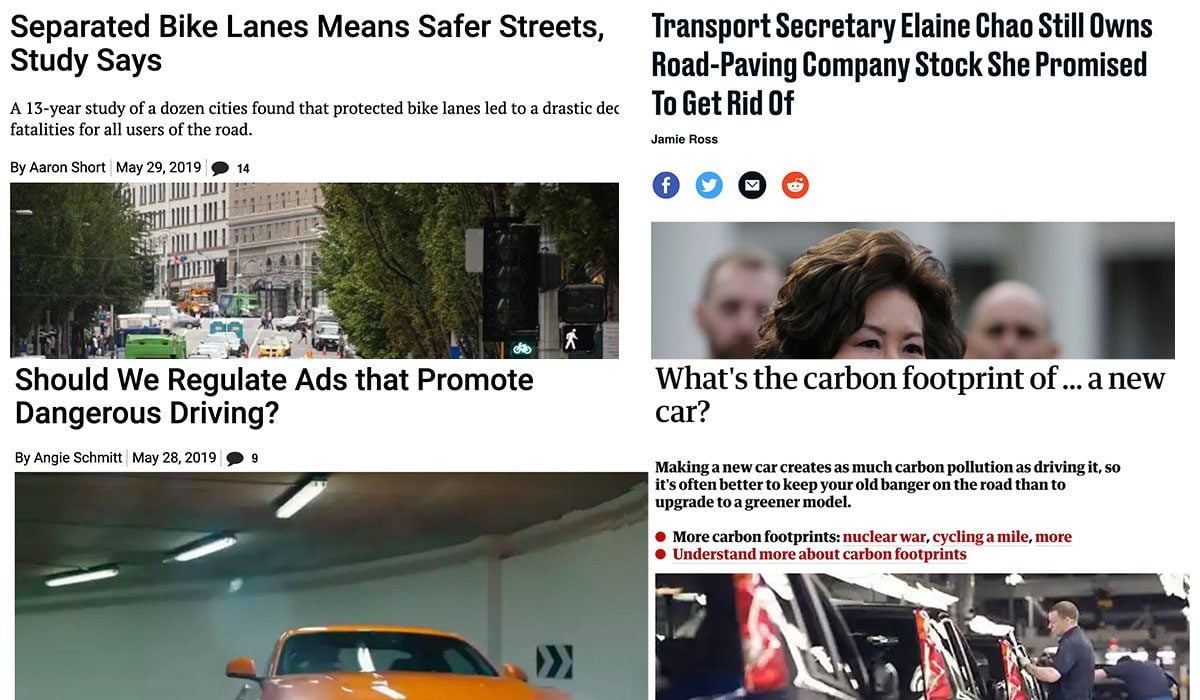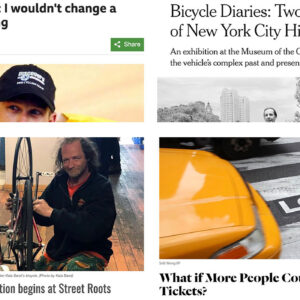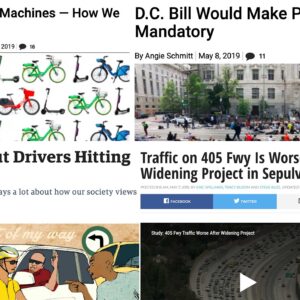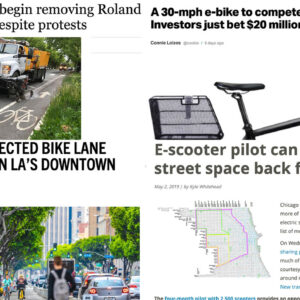Welcome to the week. Here are the most noteworthy items we came across in the past seven days…
Double duh: A major study found that protected bike lanes work. And if that wasn’t obvious enough for you, they found that paint-only bike lanes are actually worse than nothing at all.
Flower power: Continental is set to launch a line of tires derived from “dandelion rubber”, which the company says are much easier on the planet than using rubber trees.
Highway industrial complex: The US DOT Secretary holds stock in one of the largest road paving companies in America — even though she promised to get rid of it.
SF bike share bloom: San Francisco plans to quadruple its bike share fleet to 11,000 despite a legal threat from Lyft, which says it has exclusive rights and doesn’t want competitors entering the fray.
Gravel’s big year: VeloNews takes a look at why 2019 is such a banner year for gravel cycling.
Killer ads: Car ads in the U.S. promote the type violent, aggressive, illegal driving behaviors that contribute to thousands of injuries and deaths on our roads every year. Hell yes we should regulate them.
Advertisement
Just ban the damn things: “Making increasingly crowded cities more livable has to become an urgent public-policy goal,” says this opinion piece from Bloomberg News, which makes the case for banning (non-electric) cars.
True traffic relief: In Portland some think the cure for congestion in the Rose Quarter is to add freeway lanes. In Paris, they think the opposite makes more sense.
Rah-rah Rapha: Love this new initiative from cycling apparel company Rapha to help boost bike racing in the U.S.
Sigh: The U.S. government is trolling us by referring to fossil fuels as “molecules of freedom” and “freedom gas.” Seriously.
Buy used: The Guardian took a deep dive into the carbon footprint of making a new car and found, on average, it equals more emissions than what comes out of the tailpipe over a car’s average lifespan.
Tweet of the Week: An excellent example of bias in media coverage of traffic crashes from Paul Supawanich (who happens to be transportation policy advisor to the mayor of San Francisco)
https://twitter.com/tweetsupa/status/1134955267466989569
— Jonathan Maus: (503) 706-8804, @jonathan_maus on Twitter and jonathan@bikeportland.org
Never miss a story. Sign-up for the daily BP Headlines email.
BikePortland needs your support.







Thanks for reading.
BikePortland has served this community with independent community journalism since 2005. We rely on subscriptions from readers like you to survive. Your financial support is vital in keeping this valuable resource alive and well.
Please subscribe today to strengthen and expand our work.
Double duh: A couple take-aways from that article: The myth of “more cyclists equals more safety” is broken, and they state that plastic wands and empty parking spaces do not create “protected” bike lanes.
Holy cow! I’ve got a whole “Victory Garden” of dandelions, if anybody needs them…
Anyone heard the radio ad (I heard it on Pandora) that exhorts people (probably young men) to “Join the brotherhood of muscle”? It’s from Dodge, I think. A manly man with a manly voice tries to equate toughness with driving some Dodge vehicle. It’s probably the most blatant attempt I’ve heard to appeal to men’s worst qualities, but apparently it sells cars and trucks.
“Brotherhood of Muscle” is also a TV ad. And it features some driving that would be very illegal and dangerous, if done on roads open to the public.
Funny, some of us are old enough to remember when TV ads for cars did not show driving that would obviously be illegal on roads open to the public. Not ever – I do mean never – would you hear the squealing of tires or otherwise see the burning of rubber in an ad. Then, gradually, you’d see ads with cars driving fast on mountain roads, for example, with a very clear message printed on the screen warning that the ad was showing a professional driver on a closed course, and exhorting us all to observe traffic laws and drive safely.
But this was never a law. The car companies policed their advertising themselves to keep the regulators away.
Not now, though. The cautionary subtitles have been replaced by tire smoke.
There have been a number of ads in recent years not only promoting reckless driving, but the use of vehicles as weapons, if only (so far) for intimidation. The one that offended me most was a print ad for the Cadillac Escalade. It showed a picture of the front bumper and grille of an Escalade from near ground level (making it appear to loom above you), superimposed by a huge YIELD sign. That kind of crap is just not okay.
Gravel’s big year: Nothing about cycling, everything about racing. It’s just like 100 years ago. Cycling gets more popular so you see it in more places. It used to be that you took a big 4×4 truck off-roading, but now there are bicycles built specifically for it and so you see that more. There’s no big secret as to why it’s happening. As for the article, just add competition and prize money and you’ve appealed to all the people that used to be drivers. And as soon as you add competition and prize money then like everything else it stops being fun.
It is an article in a RACING magazine which probably is why it is mainly about racing. Have you been to a organized or informal gravel event/ride? I have found a pretty wide cross section of participants and in the northwest nobody is doing it to make money. It is fun way to ride and there are far fewer cars on gravel roads.
Exactly. For future reference Johnny, don’t go to VeloNews if you don’t want to hear about bike racing 😉
So apparently you did not read the article, because it specifically stated the Pros are doing gravel for fun and for something different.
Had nothing to do with appealing to Drivers, etc..
It was also about how much fun gravel riding is, did the article mention it was no longer fun?
What did you read?
Another GOOD thing about gravel bikes/riding/racing–it has the ability to drag the attention of road bike buyers away from the single-blade-knife of modern road racing bikes as general purpose recreational machines and towards more comfortable, forgiving, versatile bikes sort of like the racing bikes of 40 t0 80 years ago. What would you want to ride 60 miles of cheaply paved Washington chip seal on–gravel bike, 60 year old road bike that has a long wheelbase and fits 700 x 32 tires, or some aluminum jackhammer that barely fits 700 x 25?
Don’t get too carried away…
I still use my 17 lb. 25mm tire bike for big climb routes,
There is still nothing like low weight. My Gravel bikes are not that much fun above 10% grades.
I see quite a bit of overkill right now, people commuting on killer bikes with 44’s on.
To each his own, but the roads are not that bad.. yet.
Disagree. My 25 lb gravel bike with 2.25″ tires is fine up any grade, and yes, the roads are that bad.
Except that’s not what the article said:
>>> Perhaps even more important: Researchers found that painted bike lanes provided no improvement on road safety. And their review earlier this year of shared roadways — where bike symbols are painted in the middle of a lane — revealed that it was actually safer to have no bike markings at all. <<<
It's sharrows that are dangerous; painted lanes did not affect safety one way or the other.
That said, I am having a hard time imagining how Hawthorne heading east after the bridge would work with no bike lanes. Not more dangerous? Really? And Clinton would be safer without sharrows?
There has to be more to this than what made it to the article.
Very often it is a great improvement. Not always, of course (I’m looking at you, madame SW Broadway), but most places I’d rather have the bike lane than not, even if it’s “just paint”, and even if vehicles occasionally intrude (so long as the lane is empty when they do).
Much as I hate them when I have to bike over them, I wish instead of paint, they would selectively put in rumble strips at the inside curves where most cars cross into the bike lane. Unlike paint (and candlesticks), cars do try to avoid the noise and vibration they cause.
Or maybe those 6 inch 1/2 moon thingies, but they seem to just chip off after a short while.
I wouldn’t mind rumble strips but only if they could guarantee that the bike lane would be free of debris. I hate riding along roads that have rumble strips where I often have to move into the auto lane to avoid debris.
I also feel like bike lanes can make things feel better sometimes but they need to change the law that says that if the lane is there that bikes must use it. Or at least spend more resources on educating drivers that cyclists are allowed to leave it if hazards are present. Or pretty much spend some kind of resources on educating drivers about cycling laws at all, since a lot of the vitriol I hear about cyclists (even from friends/family) is based on misinformation about how laws are applied to cyclists. It’s hard to change the view of a lot of motorists that “all cyclists are scofflaws” when many/most of those motorists don’t even know what the laws are or how they apply.
I suspect this particular study is just reflecting where/how these bike facilities were used; I’ve seen plenty of bike lanes that were too narrow (and with little intersection protection) or sharrows marked on streets that are far too busy. Simply put: if you build CRAP versions of facilities, you will get crap results.
Plenty of other studies have found that well-designed painted bike lanes can reduce bike crashes by about 10-20% (eg look at Elvik & Vaa overview) – interestingly other road users also tend to get safety benefits. Sharrow trials in NZ found that traffic speeds reduced slightly in their presence, but they are only be recommended there for low-speed, low-volume environments (like neighbourhood greenways, low speed downtowns, and approaches to roundabouts).
Gravel riding has a bright future as maintaining the miles of asphalt we have in place becomes unaffordable and more roads get ground up and turned back in to gravel. This will accelerate in the future as the tight oil ( shale etc.) we have come to rely on due to declining conventional oil production is much lighter and has little or none of the heavy components that come off the bottom of the cracking tower to be used to make asphalt.
So we’ve been hearing about Peak Oil for decades…it just does not look like it is going to happen any time soon.
https://www.texasmonthly.com/articles/permian-basin-booming-oil-cost-west-texans/?utm_source=pocket-newtab
Agreed that Peak Oil is not in the foreseeable future. As has happened several times in the past, temporary shortages have prompted both new exploration and improvements in fuel economy, both of which combine to kick the can a long way down the road – perhaps ad infinitum.
That said, the new supply that has come online in the past decade is expensive, costing well over $50/bbl to get out of the ground. It is possible that we will have as much petroleum as we dare to consume for generations to come, but it may come at a price.
Realistically I don’t think supply constraints are going to be the thing that gets us to rein in carbon emissions. The only way it will happen is if we finally work up enough will to deliberately reduce emissions as a society. No idea when that will finally happen.
Re: New-car carbon footprints: How on earth did the Guardian conclude that manufacturing a fully loaded Land Rover causes six times the carbon out put of an economy car? Two or three times would make sense – after all, a 5000 pound Land Rover has about twice the mass of an economy car – but how does it triple from there?
Faulty logic in the “protected bike lane” article
“In Portland, where the population of bike commuters increased from 1.2 to 7 percent between 1990 and 2015, fatality rates fell 75 percent in the same period. ”
Um, Portland had ZERO protected bike lanes in2009, and still almost zero protected bike lanes in 2015. And the reduction in the fatality rate all occurred between 2000 and 2009. The fatality rate hit an all-time low in the 2009 – 2011 era, then climbed back to about 3/year since then. If anything, the fatality rate has climbed since Portland started putting in protected bike lanes.
And, even if it hadn’t, how many miles of protected bike lane existed in Portland in 2015? Maybe 7 miles? A mile on N Williams, one mile (*2) NE Multnomah, one mile on SW Multnomah, one mile (*2) on NE Cully? One mile SW Moody? And well over 100 miles of unprotected bike lanes. 95% of bicycle-miles-traveled in bike lanes were on unprotected bike lanes. So the protected/unprotected bike lane metric is at best irrelevant to their conclusions, and at best runs counter to their conclusions.
“Perhaps even more important: Researchers found that painted bike lanes provided no improvement on road safety.”
I think that Portland’s great success in reducing the fatality rate can be specifically attributed to painted bike lanes! As well as bicycle boulevards (AKA neighborhood greenways) and a host of other bits of infrastructure.
I don’t have a strong opinion in favor of protected bike lanes. I’d rather see 10 miles of decent unprotected bike lanes than 1 mile of protected. I differ from many of my peers in this opinion.
But I do have strong opinions on good research, and on only stating conclusions that are supported by the data.
Ted Buehler
I totally agree with you. I strongly suspect a correlation/causation problem in the research (perhaps erroneously) reported in the article.
In this case the causation is a pre-drawn conclusion supported by selective use of data rather than conclusion based on critical examination of the data. Who needs honesty when you have an agenda?
I heartily agree. Add in that the loud calls for so-called protected infra helps create the impression among potential riders that getting on a bike and riding instead of driving is an incredibly dangerous thing to do. That sort of thing can really depress ridership. It might explain why Eugene has gone from 9-10% cyclists to 4.4% since 2012 and is tracking to 0% by 2023, as well as the 40% drop in Davis since 2015 (when they hired a bike coordinator with a big “safety first” message).
We’re never going to be completely separated from other modes unless we ban cars outright (works for me). Therefore, if we scare people into thinking they can never ride where there are cars, we will lose all those benefits of having more cyclists like added years of life for riders relative to non-riders, less air pollution, lower greenhouse gas emissions and many others.
Davis hasn’t had a big drop. We’ve discussed this before…
In full agreement of your other comments, though, that touting “protected bikeways needed for safety” is not a message that promotes bicycling to the “interested but concerned”.
One way to deal with the deceptive and dangerous auto advertising is for a few states to institute automobile truth in advertising legislation. In this legislation , if a car is advertised breaking any of the traffic laws of that state or demonstrated to be used in a place other than the public roads in a way that is safe to other drivers and VRU’s then that model will be designated by the DMV to be only suitable to receive an ORV or Track only license plate. This designation would be applied to all versions of that car (or truck) model. If one or two states ( especially California) put such a law in place auto companies would certainly cease such dangerous and irresponsible advertising forever.
I imagine that lawsuit would make its way to the conservative-majority supreme court, and they would rule that any laws like that violate the commerce clause.
There’s something incongruous here in the article about protected lanes/sharrows/regular bike lanes. The article states that Portland has seen a decrease of 75% in fatalities, but we hardly have any protected lanes. We had no protected lanes a few years back, when our fatality numbers were already significantly down from the 1990 levels. What is the missing piece here?
OK. I know “protected” infrastructure makes some people more comfortable, and there are a few good examples (in other countries) of where it likely makes things objectively less risky (my new preferred term to replace “safer”), but I hope we have our eyes wide open when it comes to promoting and implementing such infrastructure here in the U.S.
First, when it comes to articles that promote separated infrastructure, we tend to see photos of Sunday mornings when such bikeways are full of bikes, free of pedestrians, and there is a dearth of motor vehicles. This is very similar to the “professional driver on closed course” that we see in lots of car ads—not in what it promotes, but in that it attempts to sell an unrealistic expectation. Let’s see those protected bike chutes at rush hour on Tuesday afternoon.
Second, we used to hear that creating less risky-feeling infrastructure would encourage more people to ride bikes, and that would increase safety due to “safety-in-numbers”. Now, we’re hearing that the numbers don’t matter, they don’t increase safety. The focus is now on just luring people out of cars, but is that happening? I found the following quote from the article interesting:
Here we see two supposed benefits of protected infrastructure intersecting nicely: higher ridership and lower risk. Do we know which protected infrastructure projects were completed during that time that led to this stunning increase in “safety”? There is an interesting report here that outlines a few “facts” about bicycles in Portland. According to that report, Portland has seven (7) miles of “protected” infrastructure. Did all 7 of those miles exist prior to 2015? How can we say that such protection (which we know is partly—if not largely—provided by plastic bollards and parked cars) was the cause of either higher commute rates or lower fatality rates? The rest of Portland’s infrastructure consists of sharrows (“worse than nothing”) or painted lanes (“as good as nothing”). But then, lots of Portland’s sharrows are painted on neighborhood greenways with diverters—are diverter-controlled greenways counted as “protected”? Are sharrows “worse than nothing” if they are used in conjunction with diversion? Did any of these shabby, unprotected additions of paint serve to increase ridership despite their dubious effectiveness?
Third, the report (or the summary of it on citylab) doesn’t seem to correlate reduced risk with usage of protected infrastructure, but merely the existence of it. Another interesting quote is this one:
Now, it all hinges on the definition of “areas” in the above quote, but this makes it sound a lot like all a city needs to do is install some piece of “protected” infrastructure anywhere in the city, and it can then sit back and enjoy the 44% reduction in traffic fatalities. Could it be that cities that are willing to install protection generally have a more bike-friendly culture which makes things safer? I mean, including cities like Dallas and Kansas City makes it seem like bike-friendly culture isn’t relevant, but we don’t see any specific references to ridership-up-fatalities-down anecdotes in those cities, either.
Not saying protected infrastructure isn’t worth the investment, but we should make sure we know what we’re investing in, and whether we’re doing it “right”.
US DOT Secretary: now this is the kind of corruption I care about.
Wasn’t I just reading a story about someone who has dedicated his life to improving government transparency, fairness and conflicts of interest? I bet he’s all over this.
1) Yeah just ban (non-electric (delete this parenthetical (no, the outer one))) cars. That’s fun. Feel free to ban them in your own household right now though. “Amsterdam has made itself a test case, proposing an outright ban on gas and diesel vehicles by 2030. That may sound extreme…” Ah no, it sounds like the usual 11-years-away bullshit. I’m so sick of the future. Everyone dumps all their climate predictions and their self-discipline and sacrifices there. Things never get dire for another 10 years, ever notice that? We always have 10 years. Which means we don’t have to do squat for 9.8 years. We’ll have it dialed in by then, you bet! The future is an amazing Imaginaryland full of whimsy and wonderrrr, Chaaarlieeee! (https://www.youtube.com/watch?v=CsGYh8AacgY) All the junkies and alcoholics put their rehab stints there and the world is perfect. Everybody’s fantastically rich! And totally buff and ripped! In the fuuutuuuuure!
2) Streetsblog: “Perhaps its time for the U.S., where traffic deaths are the leading cause of young people, to consider doing the same.” I always thought “bumpin’ uglies” was the leading cause of young people.
the year 2525 is just around the corner!
https://www.youtube.com/watch?v=zKQfxi8V5FA
Cities splash paint on the road to indicate a bicycle lane but then often ignore the fact that the space is more than a gutter by putting signage there, allowing it to get cluttered up, allowing construction crews to leave curb mounting wood in the lane and completely ignoring it during repaving events, sometimes even causing a separate curb to appear on the left side of the lane as a result.
I once nearly ran into a railroad tie entirely across a bike lane. This being early morning enough when I was riding with a light and the tie being entirely black from the tar treatment, I recognized it just at the last moment and skidded to a stop (it was wet) a mere foot away. It was left there by a construction crew which used it to have their tracked vehicles mount the curb but somehow got turn 60 degrees to the curb so that it was sticking out across the bike lane line. I had a hard time moving the end sticking out back to the curb but even against the curb, the thing posed an obstacle to someone riding close to the curb in the bike lane. It was too heavy to lift onto the curb itself.
I’m extremely unconvinced that paint-only bike lanes are worse than nothing at all, if that’s even what the article said. I can name many painted bike lanes – come to think of it, nearly all of them – on roads I ride, but would NOT ride if there weren’t a bike lane.
Paint is not a panacea, but it isn’t nothing either. Millions of Oregonians take to the highways, separated by mere paint from approaching vehicles going 100-120mph the opposite direction, yet the head-on carnage is remarkably small. That’s what paint does for us.